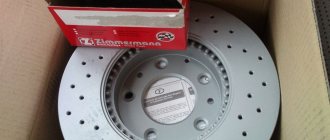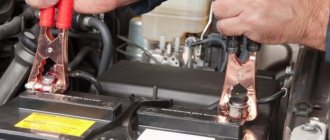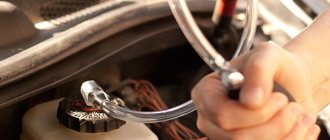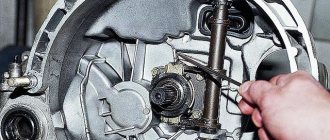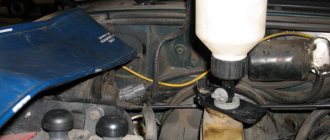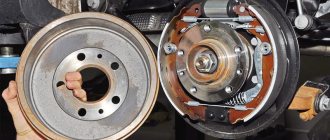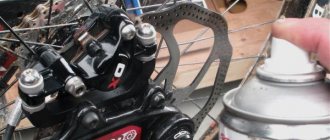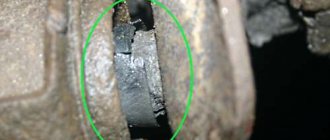Causes of a tight pedal
The quality of functioning of the braking system is most often indicated by those external elements with which the driver interacts while driving. It is the free movement of the brake pedal, which is comfortable enough for his foot, that ensures good control of the car. In general, there are hard, soft or medium brake pedals. There are several reasons for each.
A brake pedal that is too hard is not always so for a number of standard and usual reasons. The problem may also lie in the features of a particular model. Sometimes there are situations where a hard brake pedal is a banal feature of a certain manufacturer. The same large brake pedal travel is also characteristic of some of its types. When the brake pedal does not return, this is a huge problem.
If the brake pedal is oak, that is, it is quite hard to press, then there are two options - either visit a car service center, or try to solve the problem yourself, which poses a considerable risk. In general, an immediate solution is needed here, since driving with it is very dangerous not only for the driver himself, but also for those around him.
There are eight most common reasons:
- Problems with the limit switch of the vacuum amplifier. In this case, it is necessary to replace it and the job is done;
- The same vacuum booster has a special reverse-acting valve. It may start to jam or stop working, but simply replacing it will be enough to return everything to its place;
- The manufacturer also installs a special air filter in the above-mentioned part of the system, designed to prevent various third-party elements from entering the braking system mechanism. If it becomes clogged, then a hard brake pedal is something that the driver will have the opportunity to become familiar with. In this case, the filter should be replaced;
- Since the structure of the amplifier includes a special valve, there is a risk of a new “joy” - jamming of the body of this valve. This particular case is quite serious, so a complete replacement is already necessary here;
- His diaphragm can also become problematic. It may develop a breakthrough or cracks for various reasons, but regardless of the type of breakdown, a complete replacement of the amplifier is also required;
- Another common reason that a driver dreams about free play of the brake pedal of his car is a fuel leak directly into the chamber of this element. This may occur due to a breakdown of the above-mentioned check valve, which requires not only its replacement, but also the amplifier as a whole;
- The hose connecting the intake manifold and the amplifier gradually wears out during vehicle operation. This can be “cured” by replacing the hose. It can also become loose on the fitting for various reasons, one of which may well be the clamp. Here, either tightening the clamp itself or replacing it completely will help. The hoses themselves can easily become deformed during severe frosts due to temperature differences, because during driving the car’s mechanisms heat up to fairly high degrees. In this case, a tight brake pedal is only one of the possible problems;
- And the last reason is all due to low-quality brake fluid and the frequent ingress of third-party fluids into the cylinders, which leads to the gradual destruction of their sealing rings. Even in this situation, you cannot do without repairing the cylinders themselves and replacing the bad fluid with a high-quality one, otherwise the situation will only get worse.
All of the above primarily indicates that only in the case of poor car care do a variety of unpleasant situations arise. For example, it is necessary to regularly check how well the vacuum booster is doing its job.
There are a number of ways to carry out such diagnostics:
- The first method is to turn on the engine and let it run until the system is completely discharged. If after this the brake pedal is oaky, then the problem lies in the hose or amplifier. Then you should stop the engine, let it stand for a few minutes, and then check the system again and follow this process from “A” to “Z”. If after such a procedure the braking system clearly lacks “lightness” during its response, then the booster valve is most likely to blame;
- The second method is to press while the engine is not running in order to remove the pressure and completely discharge the brake system. Then you need to turn on the engine without releasing the pedal. When the amplifier is in full working order, then everything is fine. Otherwise, you should check the functionality of its parts.
Causes of brake pedal failure
Changes in the degree of effort to press the pedal occur due to a number of design violations, which can be either universal for all types of cars, or defects exclusively in certain models or series. We will consider a list of the main problems that can be called typical for modern and Soviet cars. As a rule, failure of the brake pedal is a consequence of a malfunction of the vacuum booster or brake master cylinder. A detailed analysis of the performance and changes in the brake system will reveal the true source:
- The VU air filter is clogged. This element is not cleaned. If a significant amount of foreign substances gets inside, which affects performance, it is necessary to replace the amplifier with a new analogue.
Mechanical damage to the VU valve body. With minor defects, the mechanism begins to jam, which affects the force of pressing the pedal. Such a breakdown, unfortunately, cannot be repaired, but requires replacement of the amplifier.
Damage to the VU diaphragm. A sign of the presence of this defect may be extraneous sounds when the braking system is activated. The damage is corrected by replacing the amplifier.
The tip of the VU is faulty. This reason can also cause the brake pedal to catch at the end of its stroke. To fix the problem, unlike previous breakdowns, replacement of the main element is not required. It is enough to install only a new tip.
- The check valve does not work or gets stuck - this can be eliminated by replacing this mechanism. Depressurization of this segment leads to fuel entering the cavity of the amplifier. In the future, this disables the entire unit. As a result, you need to change the control unit complete with the check valve.
Damage or loosening of the hose connecting the intake manifold to the intake manifold. In the first case, the rubber tube needs to be replaced, and in the second option, the fastening clamps will have to be tightened or replaced if damaged. This reason is the most common and requires regular monitoring and inspection of fastening reliability. The condition of the hose must be checked regularly. It is made of a special polymer, which becomes rigid when cooled, but after turning on the engine and warming up, the material becomes flexible. Because of this, its throughput is reduced. As a result of this problem, problems arise in the operation of the brake pedal. To avoid this problem, you need to purchase high-quality parts with specific thermal parameters.
Swelling of sealing rings in cylinders. If the brake pedal is not pressed, you should immediately check the condition of the elastic seals. Most often this happens due to gasoline and oil getting inside the components or using low-quality brake fluid. Depending on the degree of damage, seals and low-quality brake fluid are replaced with an analogue recommended by the manufacturer.
Why is the pedal soft?
Due to certain problems, the brake pedal frog may also be faulty. Such a nuisance can come “in full” along with other related ones. Very often, a soft brake pedal is the direct cause of a significant deterioration in vehicle control.
A soft brake pedal may be a simple feature of the model. The cause of malfunctions may be air entering the relevant system. Everything is corrected by bleeding the brake itself in order to protect it from possible problems.
In turn, air can enter the system in many ways, and if problems appear with it, then most likely it is to blame. The pipeline may well lose its seal or even burst in this case. Due to a breakdown of the master cylinder, in which the brake fluid begins to boil, corresponding problems also arise. An accompanying failure is often jamming of the piston. It is advisable to diagnose the cylinders and check the brake fluid. It would also be a good idea to do a complete health check of the machine to determine if there are any hidden problems, if any.
Personal experience of car owners.
Alexei:
“I am a driver with little experience, so it was very difficult for me to independently determine the cause of the pedal hardness. I couldn’t even figure out how to remove this or that part in order to diagnose specific problems. In the end, I took my Audi A6 to a service station. The craftsmen working there determined the nature of the damage without even removing the units. Correct diagnostics helped me significantly save on repairs.”
Ivan:
“When the amplifier of my VAZ 2114 broke down, I verified that it was faulty in a simple way. To do this, the hose is removed and the amplifier is turned off. The presence of a vacuum when starting the engine indicates that the “vacuum valve” is faulty.”
Novel:
“The vacuum booster and cylinders are very difficult to diagnose. The best vehicle diagnostics can be provided only by those car services that have pressure gauges.”
Why does the brake pedal become hard?
The reason may lie in the vacuum brake booster (VBS), a device that uses rarefied air to increase the efficiency of pressing the pedal. There are several possible problems here:
- limit switch malfunction;
- check valve failure;
- contamination of the air purifying filter;
- fuel entering the VUT chamber;
- diaphragm damage;
- wear and deformation of the hose that is used to connect the VUT and the intake manifold;
- loosening of the hose in the area of the fitting.
Another reason why the pedal becomes hard is the use of low-quality brake fluid. Many people believe that its properties do not change due to movement in a confined space, but this is not so. When a person presses the pedal, air enters the compensation holes along with the moisture contained in it. Over time, the boiling point increases, and the viscosity at low temperatures increases. Using brake fluid that has become unusable can lead to corrosion of internal parts, the formation of vapor locks, and slow vehicle response when the pedal is pressed.
Sometimes the malfunction occurs due to the cylinders. For example, when foreign liquids enter and the sealing rings swell.
Self-diagnosis
If the brake system is depressurized, air masses enter the intake manifold and engine operation becomes unstable. In such cases, car enthusiasts say that the engine is “troubling” (one of the cylinders fails, and the remaining ones work for it). This is accompanied by strong vibrations, a noticeable loss of power, misfires and popping noises in the exhaust system. Another sign that the VUT has failed is a hissing sound that occurs when you press the pedal.
If the problem lies in the amplifier, the breakdown needs to be specified, and this can be done in different ways. One of them is to turn off the engine, wait a couple of minutes and press the pedal. If it remains hard, then the check valve has failed. If the pedal becomes hard after a long period of inactivity or several presses, the problem should be looked for in the amplifier diaphragm.
Another method for diagnosing VUT is also possible. The first thing to do is press the pedal several times without starting the engine. After this, you should hold the brake and turn the ignition key. If the pedal begins to move down smoothly, it means the amplifier is working.
Video: Methods for diagnosing VUT
Vacuum booster diagnostics
Often, a sign of depressurization is unstable engine operation (tribbing). This happens due to air entering the intake manifold. It sharply depletes the air-fuel mixture entering the cylinders. If the pedal does not press when the car is running, first of all you should check the reliability of the connections
.
In addition, when the system depressurizes while the engine is running, a characteristic hissing sound is heard from the vacuum booster.
To pinpoint the problem, turn off the engine and wait a few minutes without pressing the pedal. If after this time the pedal remains hard, the most likely cause is a broken check valve.
It is very easy to diagnose the correct operation of the vacuum booster
. To do this, without starting the car, you should “pump” the pedal, then, continuing to hold it, start the engine. If the vacuum seal is working properly, the pedal will go down.
What to do if the brake pedal becomes hard
If the pedal becomes hard, it is necessary to determine the cause and eliminate it. A dirty air filter must be cleaned, and faulty limit switches, valves and hoses must be replaced. Usually this is enough for the system to work. If during diagnostics it turns out that the diaphragm is damaged, the entire amplifier will have to be replaced.
If the problem lies in the brake cylinders, they are repaired, including replacing seals and cuffs. In some cases, old parts are removed and new ones are installed in their place.
Is it possible to do something right away?
The best thing to do if you suspect a vacuum booster is broken or its elements are worn out is to go to the nearest car service center or replace the damaged parts yourself.
If there is an assumption that poor-quality brake fluid is to blame, it needs to be replaced. In this case, it is necessary to completely pump out the old one, and pour in a new one in its place. Otherwise, the situation will improve only slightly.
Other
To regularly check the brake fluid, it is better to buy an electronic tester that measures the boiling point. If it exceeds +175°C, it means the fluid has recently been changed. If it varies from +165 to +175°C, the properties have deteriorated, but it can still be used. The fluid needs to be changed if it was filled more than 2 years ago or its boiling point has dropped below +165°C.
Video: Replacing brake fluid
The main reasons for a soft or stiff brake pedal and methods for solving them
In most cases, the brake pedal becomes soft due to problems with the master cylinder or vacuum booster. It is much cheaper and easier to systematically diagnose brakes, so as not to spend money on repairs later. Because brakes fail at the most inopportune times, remember this.
The brake pedal must be pressed with increased force for several reasons:
- The vacuum booster air filter is clogged. In this case, the air filter must be replaced; · the valve body in the vacuum booster is stuck, there is only one way out - replace the vacuum booster;
- it may be that the diaphragm in the vacuum amplifier is damaged, then the amplifier needs to be changed;
- malfunction of the tip of the vacuum booster - you need to change the tip;
- the check valve in the vacuum booster does not work or is stuck, so fuel enters the cavity of the vacuum booster. In this case, it is necessary to change not only the vacuum booster, but also the check valve;
- The hose that connects the vacuum booster and the intake manifold is damaged, or the hose fastening in the fitting is loose.
You will need to change the hose or tighten the mounting clamp. If we talk about the vacuum booster hose, then you need to constantly monitor its condition. Especially in winter. The hose will be quite stiff until it is warmed up. The brakes work fine. The hose will heat up after the engine has been running for a short time, and it will become more elastic. If the delamination of the hose is not noticeable, its throughput will decrease.
There may be problems with the brake pedal;
O-rings in wheel (working) cylinders may swell. This can happen if fuels and lubricants get into them or if low-quality brake fluid is used. Brake fluid and wheel cylinders should only be replaced with those recommended by the manufacturer.
Reviews
Hard pedal - failure of the vacuum pump or vacuum booster or leaking vacuum hose. Or the master cylinder wedge.
avgor123
https://www.bmwclub.ru/threads/propadajut-tormoza-tverdaja-pedal.896947/
I had the same problem, if I let someone drive my car, they complained that the brake pedal was hard. They were sent with the statement that normal, well, there is strength - the mind... As a result, during the next maintenance, it turned out that the CH was a little high (gasoline). When I started looking into it, it turned out that air was being sucked into the vacuum brake booster through a worn-out gasket. At high speeds there is sufficient vacuum, but at low speeds the pressure gradually drops. Replacing the gasket solved the problem...
Mirage
https://audi-belarus.by/forum/viewtopic.php?t=44405
I also struggled with this pedal for a long time. I'll pump it up for a couple of days. Then again. The vacuum operator with the main brake also made a mistake. Then I replaced the pads at the rear and the problem disappeared.
aleks-tol
https://www.drive2.ru/c/2425257/
In order for the brake pedal to work well, you need to regularly change the fluid, lubricate the caliper guides, and inspect the VUT elements for damage.
Self-diagnosis methods.
Depressurization of a vehicle can be determined immediately if the engine is running unstable - “troit”. This is caused by air entering the intake manifold. During such a failure, the air-fuel mixture entering the cylinder becomes sharply leaner. A sign of a faulty vacuum booster is also the hissing sound it makes. To specify the breakdown, you should press the pedal a few minutes after turning off the engine. If the pedal stiffness does not disappear, then most likely the check valve is broken.
If the vacuum booster is in good working order, the pedal that is “pumped” without starting the engine goes down when the engine starts running.
Hard or soft brake pedal. What is the reason and what to do
The braking system is the most important component of any vehicle. Automotive designers pay special attention to brakes, realizing that safety on the road and people’s lives depend on their impeccable operation. The brakes of modern cars are quite reliable, however, you need to remember that any parts during operation are subject to mechanical, thermal, chemical and other types of loads, and therefore wear out and may fail. Brake system parts are no exception, only in this case the cost of a malfunction can be very high.
Certain signs that appear during braking can warn that something is wrong with the brakes - extraneous sounds or strong vibrations, the car pulling to the side, uneven or noticeably decreased braking efficiency and an increased braking distance.
But the first thing people usually pay attention to is the behavior of the brake pedal. It can become too tight, so that you have to press on it with force, or, on the contrary, it can suddenly turn out to be too soft, or even fail completely. All this complicates braking and can lead to serious consequences. Let's talk in more detail about what causes such symptoms and what to do in such situations.
The brake pedal has gone to the floor - what to do?
If the brake pedal becomes soft, that is, it begins to sink significantly, you should immediately check the entire brake system of the car. Most likely, diagnostics will be required at a service center and further repairs.
The main thing is to contact the service center in time
It is important to remember that all malfunctions of this kind are fraught with consequences. Brakes with a defect can fail while driving; this can probably happen on a busy avenue; such a car can only be stopped even at an average speed by colliding with some other vehicle or structure. If the brake pedal is easy to press, there may be several reasons:
- the brake cylinder is not able to hold fluid and the corresponding pressure; there may be significant wear on the cuffs and rubber gaskets;
- the wrong fluid has been filled into the brake tank;
- there are problems with the pads or discs;
- there are defects in the operation of the vacuum pump;
- The traction pedals may exhibit rust.
Problems with the brake system are clearly indicated by the presence of vibration, hissing and tapping in the pedal when it is pressed.
The pedal has become too hard
Sometimes a relatively tight brake pedal can be a feature of some car models. This nuance needs to be clarified if you have just purchased a car or are testing it before purchasing.
If everything was fine, but at some point you noticed that the pedal suddenly became “wooden” and you had to press on it with considerable force, then most likely the malfunction is related to the vacuum brake booster. It is this device that is designed to reduce the physical effort required to perform braking.
The ease of pressing the pedal occurs due to the difference in pressure in the atmospheric and vacuum chambers of the amplifier. Between the chambers there is a diaphragm with a rod that pushes the piston of the main brake cylinder (MBC), which, in turn, pumps brake fluid into the system lines and further to the working brake mechanisms. The vacuum in the vacuum chamber is created by an electric pump, and in gasoline engines the source of vacuum is often the intake manifold.
In the initial state, the cameras are connected to one another. When the pedal is pressed, the vacuum chamber is connected to the source of vacuum through a check valve, and the atmospheric chamber is connected to the atmosphere through an air valve. As a result, the diaphragm with the rod is drawn into the vacuum chamber. This reduces the force required to press on the GTZ piston. The vacuum amplifier can be made as a separate element or form a single module with the GTZ.
The most vulnerable element here is the rubber hose connecting the intake manifold to the vacuum chamber. Therefore, first of all, you should check its integrity and, if necessary, replace it.
Violation of tightness may be accompanied by non-standard behavior of the engine during braking - tripping, increasing or decreasing speed, sometimes fuel consumption increases. This is due to air leakage through a damaged hose and the entry of a lean mixture into the engine cylinders.
If the vacuum pump creates a vacuum, you need to check its serviceability.
In the vacuum booster itself, the air filter may become clogged, the diaphragm may be damaged, or one of the valves may lose mobility.
If necessary, you can purchase a new vacuum brake booster or try to repair the existing one. Be careful when disassembling - there is a spring inside, as well as a number of parts that can be easily lost. It must be borne in mind that during reassembly after repair it is not always possible to sufficiently ensure tightness, and therefore normal operation of the device.
When replacing the vacuum booster, it is not necessary to disassemble the turbocharger, and therefore there is no need to bleed the brake system.
The brakes can also become hard due to damage to the cuffs in the turbocharger or working cylinders and, as a result, a tighter stroke of the pistons in them. Treatment is to replace damaged parts or the cylinders themselves.
content .. 141 142 143 144 ..Hyundai Solaris. Increased brake pedal travel (brake pedal falls through)
Reasons for increased brake pedal travel
| Inspect all lines, their threaded connections and cylinders, and eliminate leaks. Restore the normal fluid level in the brake reservoir and bleed the system. If you find damage to the brake hoses (cracks, swelling or traces of brake fluid), replace the hoses. If you suspect defects in the master brake cylinder, replace it with a good one. | |
| The rubber cuffs of the cylinders are swollen due to oil, gasoline, etc. getting into the brake fluid. | Replace cylinders, hoses, completely drain the brake fluid, flush the system with fresh fluid and bleed |
| Overheating of brake mechanisms | Allow the brakes to cool. Use only DOT-4 brake fluids in the system. Replace brake fluid promptly |
| The gap between the pads and the drum has been increased (the automatic gap adjustment device does not work) | Replace the wheel cylinder, bleed the system |
| One of the circuits of the service brake system does not work | Eliminate fluid leakage from the brake system, bleed the system |
| Leak in the brake master cylinder | Fix the leak |
| Loss of elasticity of the internal rubber bands of the brake master cylinder | If you suspect defects in the master brake cylinder, replace it with a good one. |
| Increased (more than 0.15 mm) runout of the brake disc | Replace both drives |
The brake pedal falls off after starting the engine
There may be several reasons for such a malfunction. Quite often, diagnostics must begin with checking the brake fluid level in the reservoir. Any hydraulic system has the specified compensation tank. The tank has “min” and “max” marks, which determine the normal amount of fluid in the system.
The fact is that although the brake fluid is incompressible, the volume of fluid in the system changes. This occurs due to the fact that brake pads tend to wear out during use. As a result, the RTC pistons extend further to move the pads, which requires more fluid in the system. For this reason, the minimum level of working fluid in the tank is determined. When the amount of fuel fluid drops below the minimum, then air enters the brake system circuit, that is, airing occurs.
If the brake pedal fails, the causes of such a malfunction can often be a critical decrease in the fluid level or air ingress. When pressed, the brake pedal goes to the floor all the way, the brakes do not work completely or barely work. To prevent possible consequences, the level of brake fluid in the expansion tank must be checked visually, without waiting for the moment when the emergency lamp lights up on the instrument panel in the cabin.
If the ABS brake pedal suddenly fails or the pedal falls to the floor on cars without an anti-lock braking system, and checking the fluid level in the reservoir does not give anything (the level is normal), then overheating of the brakes may be the culprit. Brakes overheat in cases where there is intense and frequent braking at high speeds, constant and prolonged driving at low speed with the brake pedal pressed (for example, descents on mountain serpentines). More often, deterioration of the system in such modes occurs in conjunction with high outside ambient temperatures.
After replacing the brake pads, the brake pedal fails
New brake discs and brake pads should be worn in. While the grinding is not completed, the car may jerk after pressing the brake, the brake pedal begins to vibrate, and when braking, light vibrations can be transmitted to the steering wheel. Let us add that the general grinding in of new pads and discs takes from 250 to 400 km. mileage If the symptoms do not stop, then you should check the quality of the parts and the correct installation of the elements.
A common cause of brake problems, where the brake pedal slowly sinks, is a damaged or misaligned brake caliper that is present in the design of the brake system. The displacement of the vertical axis of the caliper relative to the axis of the brake disc does not allow the system to work normally. Also, the caliper may be in good working order, but poorly secured. In such cases, the brake pads are simply not able to properly rub into the disc.
When the engine is running, the brake pedal falls down
The most common reasons for the brake pedal to fail when the car is running are air in the system, problems with the turbocharger, low fuel fluid level, critical wear of the pads/discs, overheating of the brakes, etc.
When the brake pedal does not fall, but remains very stiff after starting and the effectiveness of the brakes is greatly reduced, then the brake booster should be checked. Additionally, its malfunction is indicated by the fact that the engine speed fluctuates when you press the brake, although the fluid does not leave the brake system reservoir, and also when the engine is turned off, the brake pedal always remains elastic, and not after several presses.
The brake pedal fails: the brake fluid does not drain
If there is a leak, the brake system inevitably becomes airy. It turns out that if the brake pedal sinks, but the fluid does not leave, this does not mean that the system is sealed. Two or three drops of fuel oil will not affect the level in the reservoir, the leak itself may be difficult to detect, but the brakes will not work properly.
Brake fluid may be leaking through the master cylinder, but the leak can only be detected by disconnecting the master cylinder from the brake booster. It often happens that the cylinder is not completely filled.
After changing the brake fluid, the brake pedal fails
First of all, this may mean that air remains in the system.
If the brake pedal fails after repair, then there is a high probability that errors were made during assembly, the system is not pumped well enough, there are brake fluid leaks, etc.
Brakes lost after heavy braking
The reason may be a break in the brake hoses, tubes, or breakdown of the brake cylinders (main or working). The brake pedal also drops sharply when there is severe wear on the discs or brake drums or brake pads. In this case, the piston of the working cylinder is pushed out.
Another reason may be overheating of the brake fluid during very active braking (brake overheating).
content .. 141 142 143 144 ..
How to make sure the vacuum booster is working properly
First you should do a visual check. Make sure there are no brake fluid leaks and the booster housing is not damaged. Check the integrity of the hoses and the tightness of their connections to the fittings. If necessary, tighten the clamps.
A hissing sound that occurs when you press the brake pedal may indicate a leak. This hissing often persists for some time after the engine is turned off and then it can be heard quite clearly.
There are several ways to check the performance of the vacuum booster.
1. The engine must be stopped. Press the brake pedal 6-7 times in a row to equalize the pressure in the booster chambers, and then squeeze the brake all the way and start the engine in this position. If the amplifier is working properly, a vacuum will appear in the system. Due to the pressure of the diaphragm, the rod will move, pulling the pusher along with it. And since the pusher is mechanically connected to the pedal, it will lower slightly, and this can easily be felt with your foot. If this does not happen, it means that a vacuum has not arisen in the system. If you have any doubts, try the second method.
2. Turn on the engine, let it idle for a few minutes, then turn it off. Press the brake fully two or three times and release the pedal. If the vacuum booster is working normally and there is no air suction, then the first one or two presses will be soft, and the subsequent ones will be noticeably tighter. If you don't notice any difference in the pedal travel, then there is a problem with the amplifier.
3. With the engine running, depress the brake pedal and, while holding it down, turn off the engine. If you now remove your foot from the pedal, it should remain in the lowered state for some time, thanks to the remaining vacuum in the vacuum chamber of the amplifier.
How to check the vacuum brake booster
The braking system of a car is constantly exposed to loads, and in the so-called aggressive style of driving on city streets, these loads increase exorbitantly. In general, influences of this kind are carried out constantly, even if you prefer a loyal level of speed. Therefore, the brake system must be diagnosed with enviable regularity in order to provide the motorist with the maximum degree of safety. Malfunctions in the vacuum amplifier occur, as a rule, due to the loss of condition of the diaphragm located inside this unit. It may burst or become cracked; there is also natural aging of rubber and loss of its qualities. What's the result? The diaphragm stops forming a vacuum. In some cases, the exhaust valve may also fail.
To check the functionality of the vacuum amplifier, you need to resort to the following manipulations:
In general, each time you press the brake pedal, the engine speed will decrease slightly, however, if the difference becomes significant, it is worth visually diagnosing the hose connecting the amplifier to the power unit. If it has any defects, the collector will become leaky, and accordingly, you won’t have to count on normal mixture formation and the motor will operate unstable. The solution is simple - change the damaged hose.
The brake pedal is too soft
If pressing the pedal has become too soft, it means there are air bubbles in the hydraulics and then the system should be pumped, or there is a loss of working fluid. The first thing you need to do is check the brake fluid level. If it is below the permissible level, the hydraulic system must be carefully checked for leaks. A leak may occur at the connection points between the tubes and fittings due to poorly clamped clamps, and the hoses themselves may be damaged. Working fluid can also be lost in wheel brake cylinders if the seals are damaged. After eliminating the leak, you will also need to bleed the brake system hydraulics to remove air from it.
If the brake fluid is of poor quality, contaminated, or has not been changed for a long time and has lost its properties, then heating during sudden braking can quite easily lead to its boiling, and then the brakes will become “wobbly” and the car itself will be difficult to control. An old, dirty, or inadequate brake fluid can cause seized brake cylinders, damaged seals, and other problems. The conclusion is obvious - pay attention to the condition of the brake fluid and change it in a timely manner.
Another reason for a soft brake pedal is the hoses, which are made of rubber and wear out over time, becoming loose. When hydraulic pressure builds up during braking, they simply inflate. As a result, the brakes become too soft and braking becomes less effective.
An extreme and very dangerous manifestation of soft brakes is pedal failure. This occurs due to significant leakage of fuel fluid or damage to the sealing rings in the gas turbine engine.
An excessively soft brake pedal, and even more so if it fails, requires an urgent solution to the problem. You need to stop immediately, braking with the engine or handbrake, and then find and correct the problems.
Results
Other problems with the brake system are also possible - wear or oiling of brake pads, discs and drums, jamming of wheel cylinders and caliper guides. But one thing is clear - the braking system requires serious attention. Regular inspection, prevention and replacement of the vehicle, immediate response to problems and timely troubleshooting will allow you to feel more confident on the road and avoid many unpleasant and dangerous situations.
Use only high-quality spare parts, and in order not to run into fakes, purchase them from trustworthy stores.
Brake problems: hard or soft pedal - diagnosis and repair
In my article today I want to talk about the brake pedal , namely what it should ideally be, tight or, on the contrary, soft, how to find this golden mean?
By and large, the brake pedal can have several positions and states.
The first state is the one provided by the manufacturer, when when you press the brake pedal there are no dips or jerks, and no special effort is required. There are also two other unpleasant pedal conditions that can cause driver anxiety.
This refers to the state of the pedal when it is excessively tight or, on the contrary, very soft. Both one and the second phenomenon are equally unacceptable and indicate malfunctions and the need for urgent repairs of the brake system.
A stiff brake pedal can become stiff for several reasons, and they may not necessarily be associated with the traditional “sores” that are typical for all brake models. However, I still propose to consider the most common of them, and I will also try to give practical advice on how to eliminate them.
Most problems that cause the brake pedal to become soft are related to either the vacuum booster or the brake master cylinder.
Reasons why the brake pedal becomes hard:
1. Clogged air filter of the vacuum booster. Treated by replacing the air filter;
2. Sticking of the valve body in the vacuum booster. The vacuum booster needs to be replaced;
3. The vacuum booster diaphragm is damaged. Solved by replacing the vacuum booster;
4. Faulty vacuum booster tip. The tip should be replaced;
5. Sticking or failure of the check valve in the vacuum booster. To eliminate, it is necessary to replace the check valve;
6. The check valve of the vacuum booster is faulty or the seal is broken, resulting in fuel entering the chamber of the vacuum booster. The vacuum booster with check valve should be replaced;
7. Damage to the hose that connects the vacuum booster and the intake manifold, or the hose fastening on the fitting is loose. It can be treated by replacing the hose, or, if possible, by tightening the fastening clamp. The condition of the hose should be regularly monitored, this is especially true in the cold season. As long as the hose is cold, it retains the necessary rigidity - the brakes function normally. However, after several tens of minutes of motor operation, the hose heats up and becomes more elastic. If, for example, during inspection you do not find delamination, the capacity of the hose will decrease, which in turn can cause problems with the brake pedal.
8. The sealing rings in the working wheel cylinders are swollen; this often occurs as a result of fuel and lubricants getting on their surface, or as a result of using low-quality brake fluid. To correct this situation, it is necessary to repair the working brake cylinders and replace the brake fluid
Here are several ways to independently check the performance of the vacuum booster.
First of all, start the engine to allow a vacuum to occur in the system. After this, press the brake pedal; if the pedal is hard, this is a clear sign of a faulty hose or amplifier. Then turn off the engine and wait 5-7 minutes, do not press the brakes.
It is necessary to specify the malfunction; to do this, press the pedal. If it is still hard, most likely the fault lies in the vacuum booster valve.
There is also another test. When the engine is not running, it is necessary to depress the brake pedal several times in order to remove the vacuum in the brake system. After this, without releasing the pedal, you need to start the engine; if the pedal begins to move down a little, the amplifier is in order.
Cause of soft brakes
A soft brake pedal, as a rule, simultaneously indicates several breakdowns in the brake system. More precisely, there are many reasons why the brake pedal can become soft. Sometimes this phenomenon is also called brake pedal failure.
The most common reasons why brakes may become soft are:
Air brake system. Troubleshooting occurs by bleeding the brakes and removing air from the brake system.
Airing can occur for the following reasons:
1. Low level of brake fluid in the expansion tank, depressurization of the brake system;
2. The main brake cylinder is faulty. A malfunction of the working cylinder occurs as a result of boiling brake fluid or when the piston jams. This malfunction can be eliminated by repairing the brake cylinders, or replacing the brake fluid.
I wish you success in carrying out independent diagnostics and repairs of the brake system. Don’t delay this, no matter how you twist it, working brakes are the key to your safety, as well as other road users.
Hit the pedal when braking: causes and solutions to the problem
The safety of the driver and passengers depends on the technical condition of the vehicle. Any road riding is a risk. While driving a faulty car, the driver exposes himself and other road users to unnecessary risk. The braking system in a car is key, because without working brakes the driver simply will not be able to stop the car, which will continue to move even with the brake pedal pressed. When a car does not respond to pedal pressure, this is an obvious problem that requires an emergency solution. But in addition to the obvious problems, there are also non-obvious ones, for example, when the pedal hits when you press the brake
.
Many car owners, at the first manifestation of a symptom of a brake system failure, sound the alarm and go to a service station. However, some motorists continue to drive a faulty car, deliberately exposing themselves and others to danger. Pedal beating is a serious problem that cannot be ignored. Next we will tell you why the brake pedal hits
and how to act in such a situation.
The design of the brake system and the main cause of pedal beating
The pedal hits the pedal when braking: causes and solutions to the problem.
Conceptually, a car's brakes form a hydraulic system and function on the same principle. Not a single modern car can do without a brake pedal, a master cylinder (MBC), brake wheel cylinders, a circuit (pipes, hoses), and a brake fluid reservoir. Depending on the model and modification, the car’s braking system may include ABS, a vacuum booster - these are not the main elements, but auxiliary ones that help increase the safety and comfort of the car. The principle of operation of the system is quite simple: the driver presses the brake pedal, muscular force is transmitted to the GTZ, which converts mechanical energy into hydraulic energy. Due to the increased pressure of the brake fluid, it acts on the working cylinders. The result of one simple action - pressing the brake pedal - is the pressing of the pads to the brake discs. The car begins to smoothly or sharply reduce speed, it all depends on how strong and sharp the pedal was pressed. It is very important to have at least a minimal understanding of the structure and principle of operation of the brakes before moving on to the main reason - why the pedal hits when you press the brake
.
Being a hydraulic system, brakes have all the features of hydraulics. When the brakes slam while braking
, the opposite effect occurs - the actuator returns the resulting mechanical force to the GTZ.
Often this becomes the cause of an unpleasant phenomenon. Why is this happening? The thing is that with active driving, natural wear of discs and drums occurs, and the elements of the system are erased, as a rule, unevenly. Often, due to constant exposure to high temperatures, the surface of the discs becomes distorted (aggressive driving, frequent and sudden braking). As a result, the pads are pressed against the discs not over the entire area, but with obvious dips in problem areas. Experienced drivers also call this failure “failing” of the pad. The malfunction makes itself felt especially clearly while driving at high speeds. In such cases, drivers note that they hit the brakes when braking at high speed
. First of all, you should inspect the discs and drums; it may well be that they have simply exhausted their service life.
Other Possible Problems
The driver’s task is to monitor the condition of the brake system and fluid level. If the liquid level deviates from the norm, the required amount of substance must be replenished for adequate operation of the main actuators. But when there is a breakdown, you should act differently. The driver may also be annoyed by:
Hit the pedal when braking: causes and solutions to the problem
- Brake pads. Not only discs, drums, but also pads can provoke a return of force into the pedal. Disassemble the brakes and carefully inspect the surface of the pressing pads. They are prone to sticking on the drums and partial or complete destruction. If necessary, replace with new, original copies.
- Brake drum. If the brake pedal hits when braking on a VAZ
, it may well be that the rear drums are clogged with dirt and dust. It would not be superfluous to check the surface quality of the product. If the drum becomes deformed, it will certainly provoke unnecessary vibrations that will be transmitted to the pedal.
- Brake cylinder. Improper operation of the brake cylinders is another common cause of the disease. Often they “sour” and cease to cope with their main purpose. Try treating them with WD-40, sometimes this will return the cylinder to a working condition, but most often it is the part that needs to be replaced.
It often happens that a car owner changes literally everything, but the problem remains. If you continue to hit the pedal when braking, remember what elements were installed on your car - original or analogues. A lot depends on the quality of the parts, including the stability of the brake system. In general, it is best not to skimp on brakes and immediately purchase quality products. In this case, the work must be carried out by a competent specialist, because in case of incorrect installation of the pad, disc or drum, the above-described symptom may occur.
I replaced the pads , discs, drums - the pedal still hits, what should I do?
Sometimes replacing drums does not bring the desired result - the pedal still continues to beat. It is very important to “break in” the new brakes the first time, drive carefully and not exceed the speed limit. It may well be that 2-3 thousand kilometers after replacing the worn-out elements of the system, the pedal will stop hitting. If this does not happen, and the problem continues to manifest itself, you should look for and eliminate other faults. Experts also identify indirect reasons why the brakes slam.
.
They are not directly related to the brakes, but can be very directly related to the manifestation of various symptoms of malfunction. The first thing you should check is the wheel bearing. Because of the bearing it hits the brake pedal
extremely rare, but if the car's wheels have been brought to a terrible state, bearings cannot be ruled out. They should be checked first during diagnosis.
After wheel bearings, the most popular causes of problems are:
- unbalanced wheels - be sure to check the car on the stand, set the correct angular wheel alignment values;
- incorrect tightening of the bolts - it also happens that the driver spends a lot of money on replacing pads and wheel bearings, and then discovers that the tightening torque of the bolts is incorrect;
- If the front levers are broken or worn out, you will need qualified assistance and auto repair.
If you were able to detect a worn out, broken part yourself, replace it immediately. You should not try to restore it, “patching it” on the go, because under any average load it will completely fall apart and bring other, significant problems. When you realize that the pedal is hitting the pedal when braking, but have no idea what could have caused it, go to the service center without hesitation. In this case, saving time and money is not the best option.
Qualified service station personnel must check the geometry of the discs and rams, inspect the main components of the brake system and “load” the car on a special stand. An integrated approach to identifying and eliminating breakdowns will certainly bear fruit. If you are well versed in machines, then you can try to cope with the task yourself. To do this, you need to have a set of the necessary tools on hand and have the details of the nearest automobile store in order to purchase the necessary part after inspecting and diagnosing the car. High-quality and correctly performed work using original spare parts will be the key to stable, smooth operation of the brakes.
Address in Zen
zen.yandex.ru/id/5d02084390324000b9cde428
The brake pedal has become hard: what could be the reason?
The braking system is the basis for the safe behavior of a car on any road.
If it behaves abnormally, be it the main brake or the parking brake (handbrake), it is recommended to immediately eliminate the malfunction. This is directly stated in the traffic rules, and this section of the rules must be taken into account. Malfunctions can manifest themselves in different ways. For example, the brake pedal has become hard - there may be various reasons for this. But until you understand what’s going on and fix the problem, you can’t go anywhere. Repairing the brake system is not a very expensive or very difficult auto repair if you have a lift or overpass. But problems that may arise in a real traffic situation can have the most tragic consequences. Most inexperienced drivers, accustomed to stable brake operation, are simply lost when the car does not brake with normal force, or the pedal suddenly falls. Only special training at the race track will allow you to brake the engine correctly. And the last “line of defense” is the handbrake, so it must be in good working order.
Design of a standard brake system
Basic design of the brake system
- The brake pedal and the levers going from it to the amplifier.
- Vacuum booster (VA) - uses rarefied air from the engine to facilitate pedal operation.
- Master brake cylinder – evenly distributes the force received from the brake control unit to each wheel. Brake fluid is used to transmit pressure.
- Metal tubes and rubber hoses - through them, fluid is pumped from the master brake cylinder to the brake workers.
- Brake wheel cylinders and brake pads are installed on all four wheels and provide braking action to each brake disc or drum.
Swelling of rings in cylinders.
The condition of the brakes largely depends on what kind of brake fluid is used during operation. If it is a product of a well-established company, the vehicle is rarely damaged or disabled. But if the fluid is of poor quality, one or more cylinders may not function well due to their O-rings swelling. The same thing happens when fuel and lubricant gets on the ring.
Previously, especially in the era of the Soviet automobile industry, the car owner sooner or later had to sort out the working cylinders. Such an activity was long and burdensome even for professionals. But now hardly anyone will do this if the vehicle is faulty. From the point of view of saving time, it is much easier to change them, and at the same time the brake fluid. However, you can avoid unnecessary financial costs if you use high-quality, albeit expensive, liquid from the very beginning, since repair costs are always higher.
If the pedal is not pressed
The pedal force is facilitated by a vacuum booster.
The brake pedal is too tight - check the vacuum booster.
This means that if the pedal has become hard or is pressed too hard, the reason is related to it. This could be a simply disconnected or cracked rubber tube coming from the engine exhaust manifold. Or a breakdown of the device itself, most often associated with its depressurization.
In rare cases, breakage or disconnection of the levers may occur - this will be associated with characteristic sounds when pressing the pedal. Sometimes a foreign object or a bent part of the mat gets under the pedal.
If the brake pedal is pressed hard: diagnostics
As you can see, a tight brake pedal is often due to problems with the vacuum booster. At the same time, its operation can be quickly checked on the spot.
To diagnose VUT, you can use two methods. In the first case, you need to start the engine for the vacuum booster to start working. Normally, the pedal is soft; after two or three strong presses on the brake, the engine speed will briefly increase.
If, after starting the engine, the brake pedal is hard, then you need to check the hose or the booster itself. Also, a lack of pedal softness may be associated with the brake booster valve. Problems are indicated by hissing and extraneous sounds when you press the brake.
Another test involves pressing the brake several times with the engine off. Normally, the pedal should be soft for 2-3 presses, then it becomes hard. After this, you should press the brake and start the engine without releasing the pedal. The pedal should go down after the engine starts. If this does not happen, then you also need to look for a problem with the VUT.
Dips when pressing the pedal
High-quality and clean brake fluid is the key to normal brake operation. It is thanks to its high density that the braking force is quickly transmitted to the wheels. Over time, it deteriorates its properties, air bubbles form in it, and moisture accumulates.
If the brake pedal is either soft or hard, check the brake fluid level.
If a slight depressurization occurs in any area, the liquid flows out and air gets in its place. As a result, the brake pedal is either soft or hard. Several gentle pressures lead to the accumulation of pressure in an insufficiently dense liquid. Then it works, and effort appears.
First of all, you need to check the presence of fluid in the expansion tank of the brake system; it is located on the master cylinder. If there is no liquid in it, you cannot drive; simply refilling it will not solve the problem. If you are planning a DIY repair, you will have to find the location of the leak - it could be any of the cylinders or some kind of tube.
Brake operation when the engine is off
The pressure on the pedal is related to the vacuum booster. And the VU itself can only work with the engine turned on. When parked for a long time, the pressure in the vacuum chamber becomes atmospheric - the amplifier does not work. When you press the pedal, the force is transmitted directly from the levers to the master cylinder. The resistance on the pedal increases by 3-5 times.
A hard brake pedal after parking is normal.
If you start the engine while holding down the pedal, it should fall slightly. You can go safely.
